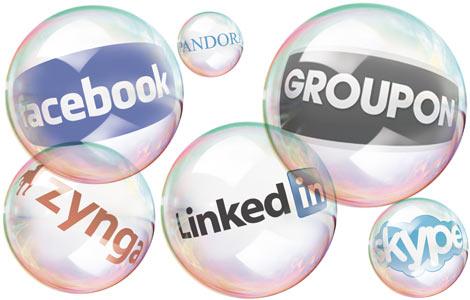Do high valuations for Uber, Snapchat and BuzzFeed herald a new tech bubble?
Overinvestment also implies bust, though. The question of which moment marks the peak has been raised repeatedly: at the time of corporate social network LinkedIn's flotation in May 2011, with Facebook's purchase of mobile picture network Instagram for $1bn in April 2012, Facebook's flotation in May 2012, Twitter's flotation in November 2013, and so on. Last week's cash injection into BuzzFeed was just the latest trigger for headshaking on both sides.
Writing for Business Insider last November, co-founder Jim Edwards laid out a lengthy list of reasons of why tech is overvalued: low interest rates are driving a wave of funding into companies as "virtually any other kind of investment [than cash in the bank] is likely to pay more", and there is a shortage of skilled staff. Worst of all, he suggested, was that companies with "broken" business models (such as design retailer fab.com, which laid off hundreds of staff, yet won more funding), or without meaningful revenue (such as image-pinning service Pinterest), or with no revenue at all (Snapchat) were all highly valued.
The key dispute is whether large user numbers translate into large profits. Veterans of the first dotcom bubble recall how "eyeballs" were, for a time, the most important metric: how many people were looking at your site?
Those making the investments – and many on the sidelines – are certain that this time things are different. August 1998 saw the launch of pets.com, selling pet food and products online ("because pets can't drive!"): it went from flotation to liquidation in less than nine months. What's often overlooked is that it had more than half a million customers at its demise – remarkable in the pre-broadband era. But then those customers were getting a bargain: the company was selling goods for about a third of what it had paid for them, an unsustainable business model in any circumstances.
The difference from the 1990s, and even from the mini tech boom of the mid-2000s that halted with the credit crunch in 2007, is that there are now multiple proven internet-only business models – from Google's search-based advertising, to Facebook and Twitter's socially based advertising, to LinkedIn's "freemium" model, which charges users for better access.
One area under close focus has been the "sharing economy" – which tends not to be about sharing at all, but about making money out of underused things – be they space, time or products.
Uber and room rental company Airbnb like to be described as part of this – Uber prefers to be called a "ride-sharing company" (and insists it is not a "taxi company"). The "sharing" tends to be mediated (for money) by the company. Thus Uber doesn't employ cab drivers or (obviously) customers, but links the two, and sets the price for a journey – including its "surge pricing", when high demand can increase a fare fivefold.
But it contains huge value, according to a new study from PricewaterhouseCoopers (PwC). "In some ways, the sharing economy is a throwback to the pre-industrial age, when village communities had to share resources to survive," said John Hawksworth, PwC's chief economist. "They built up trust through repeated interactions with people they had known all their lives. Digital communications allow sharing across a global village … with trust established through electronic peer reviews."
Uber's valuation has been queried, but some see it as justified – its model of uniting buyers and sellers separated by short distances has wide applicability.
Can Snapchat make money? Certainly, by selling in-app purchases, or "stickers" (virtual elements to attach to a message or picture) – a very profitable model for the Line messaging app in south-east Asia. Pinterest is exploring "promoted pins". Twitter is ramping up its advertising. And don't forget that when Google started, its founders had no aim except to offer a really good search engine – and no clear business plan.
Dixon is certain this isn't a bubble; this is an embedding of technology companies from one sector into everything. "Tech is now spreading through every industry and every part of the world," he said. "The most interesting tech companies aren't trying to sell software to other companies. They are trying to reshape industries from top to bottom."
RISING STARS
SNAPCHAT
Social network of photos and videos that vanish after seconds - minimising embarrassment to sender
Funding? $163m so far
Potential? Could make money from stickers and extras, or add-on functions
UBER
"Ride-sharing" company connects drivers with would-be passengers, and sets prices
Funding? $1.5bn so far ($17bn valuation)
Potential? Makes money from drivers and passengers. Is trialling a courier system for packages, called Rush. Controversial and banned in some cities
AIRBNB
Accommodation business that matches people who have spare rooms or homes with people wanting a short-term stay
Funding? $794.8m so far
Potential? Makes money as the intermediary between owner and traveller. Controversial because seen as riding roughshod over local regulations. Banned and fined in some cities
PINTEREST
Image-bookmarking social network
Funding? $762.5m
Potential? Among other methods, "promoted pins" from brands and advertisers offer a simple way to connect to users - and the visual basis makes ad-blocking unfeasible. Popular with women, a hard-to-reach web demographic
BUZZFEED
Made listicles a thing while keeping its eyes on making money by using technology to reach more people
Funding? $96.3m ($850m valuation)
Potential? Some see it as operating like an advertising agency - offering a service to find innovative ways to get adverts in front of people
SLACK
Team communication tool that links file-sharing, messaging, archives and notifications; created by Flickr founder Stewart Butterfield.
Funding? $60m
Potential? Seeing explosive growth in Silicon Valley as startups tackle "email overload"
Charles Arthur

